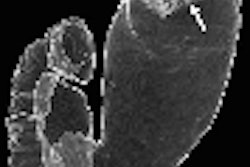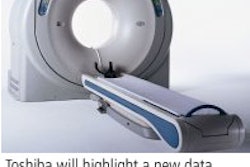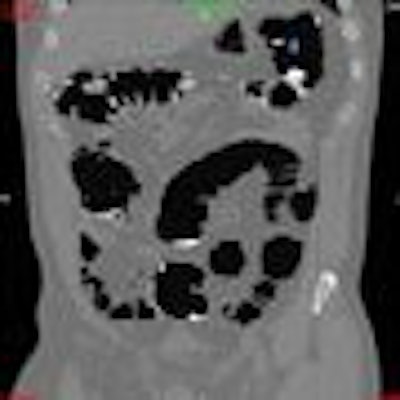
Deciding which colon cleansing preparation to use before virtual colonoscopy depends not only on the needs of the patient, but on the reading method the radiologist will use to interpret the CT data. For all the value and simplicity 3D can add to VC reading, 3D workstations inevitably run into problems with prepless VC, while 2D axial reading of unprepped colon data can be tedious and time-consuming as well.
In a presentation at the 2005 International Symposium on Virtual Colonoscopy in Boston, Dr. J. Richard Choi from Walter Reed Army Medical Center in Washington, DC, and the Uniformed Services University of the Health Sciences in Bethesda, MD, surveyed the landscape of colon prep options, and discussed his facilitys' preferences for dealing with today's patient-friendly but radiologist-confounding preps.
The purpose of the prep is to clean out the colon before imaging, and sometimes also deliver stool and fluid tagging agents, he said.
So-called wet preps, such as polyethylene glycol and sodium phosphate preparations, leave more residual fluid in the colon.
"The advantage of a wet prep is that there tends to be less debris along the wall of the colon because the fluid that's present within the colon wall tends to wash the colon wall," Choi said. "However, if you don't tag the fluid or the tool, you can obscure the colonic wall with that much fluid. It causes a large fluid shift and it tends to be more uncomfortable for the patients."
The drier laxatives, including magnesium citrate preparations, Fleet enemas, bisacodyl tablets, and the LoSo Prep (E-Z-EM, Lake Success, NY) tend to be easier for patients to take, and leave the colon wall drier for reading.
"The disadvantage is if you're doing 3D VC, the additional solid debris along the colonic wall makes it a little bit more difficult to navigate through," Choi said.
Generally, people who are young and healthy get the Phospho-soda (Fleet Pharmaceuticals, Lynchburg, VA) prep because they're able to tolerate the fluid shift that can occur with the double dose of Phospho-soda, he said. At his institutions, polyethylene glycol preps are generally reserved for elderly and debilitated patients, and inpatients.
Phospho-soda prep subjects are encouraged to drink plenty of fluids, and they are given a cocktail consisting of Dulcolax tablets (Boehringer Ingelheim, Ingelheim, Germany), the Phospho-soda prep, barium, and 120 cc of Gastrografin (Schering, Berlin). The regimen for polyethelyne glycol patients is similar but without bisacodyl.
Prepless preps
These days there is increased attention on improving the prepless or minimal prep VC exam, a difficult undertaking to be sure, but one that could potentially make VC easier on the patient and thereby increase colorectal cancer screening compliance.
"Why prepless? When we talk to patients who have undergone VC they describe the prep as the worst part," Choi said. "Severe fluid shift that can occur with certain types of prep is contraindicated in some patients, especially the elderly and debilitated. And it's one less impediment to screening if you can offer a laxative-free VC."
Prepless VC was shown to be workable in a recent study by Dr. Philip Lefere and colleagues in Belgium, who used a low-residue diet, fluid restriction, and various barium formulations in a small group of patients -- and found adequate tagging in most of them, Choi said.
Also this year, Dr. Riccardo Iannaccone and colleagues from Rome produced high sensitivity and specificity in a study of 180 average-risk patients who underwent prepless VC followed by conventional colonoscopy as a reference standard.
"However, there's no clinical proof of efficacy in a large clinical trial for prepless VC," Choi noted. And with prepless, fecal tagging is required to differentiate the stool from the polyps, and fluid tagging is recommended to visualize submerged lesions. Digital stool subtraction schemes are available to remove tagged fluid and stool, but the current generation of electronic cleansing software leaves artifacts related to the electronic cleansing.
Prepless VC is generally contraindicated in patients with a strong history of constipation, Choi added. "If you haven't gone to the bathroom in a week, this is probably not the type of exam you should do," he said.
Prepless study
Choi's institution has initiated a new study of prepless VC in up to 600 patients who are scheduled for routine screening colonoscopy, he said. They will undergo laxative-free VC followed, within three weeks, by segmentally unblended conventional colonoscopy.
Patients will consume a commercial low-residue diet for two days before the exam, followed by a clear liquid diet for 12 hours prior to the scan, he said. Stool tagging will be accomplished with six doses of a 40% barium solution and 120 cc of Gastrografin. CT colonography data will be acquired on either an eight- or a 64-slice scanner using 1.25-mm slice collimation, and a reconstruction interval of 1 mm. The results will be read on a V3D Colon (Viatronix, Stony Brook, NY) workstation.
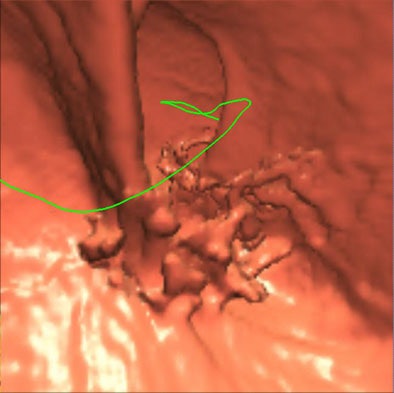 |
| Three-dimensional endoluminal view (above) and 2D MPR (below) of a patient who underwent prepless VC with the aid of a NutraPrep (E-Z-EM) low-residue diet for two days before imaging, and 120 cc of MD-GastroView (Mallinckrodt, Hazelwood, MO) iodinated oral contrast the night before the exam. |
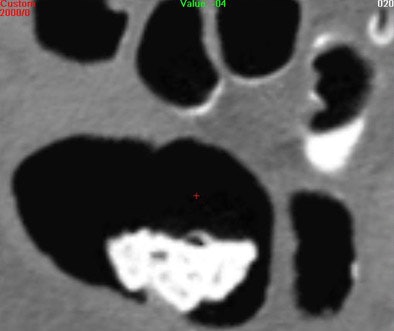 |
As Iannaccone's team found, Gastrografin has a laxative effect that helps prepare the colon for imaging. Choi told AuntMinnie.com that the 120-cc dose will probably remain constant for the duration of the study, though it could potentially be cut in half.
Reading prepless
"The problem with doing a 3D fly-through is that you may see an area where there are an awful lot of these pseudopolyps (false positives)," Choi said. "In some portions where the colon is relatively clean, you can actually make out the wall, but in most cases the current generation of VC software does not allow for the efficient subtraction of contrast-tagged solid stool."
The digital subtraction software leaves subtraction artifacts; partial volume artifacts, motion artifacts, foreign bodies, and extrinsic masses must also be dealt with. "Differentiating between true polyps and pseudopolyps is hard," Choi said. "My conclusion is that you cannot read laxative-free VC with 3D."
Instead of 3D, Choi said his group uses a magnified 2D multiplanar reconstructed (MPR) view of the colon wall that is orthogonal to the centerline of the colon, read, like 3D, on the Viatronix workstation.
With the magnified 2D, "you see 100% of the colon surface with simple fly-through, and it's easier to differentiate polyps and folds compared to looking at, say, a magnified axial view," he said. "However it's more difficult to (determine) the absolute location of the polyps."
Overall magnified 2D MPR view picks up polyps fairly easily, Choi said, and for individual lesions a 3D view can be used for troubleshooting. The new study will provide more insight into the 2D reading method.
"Most patients are relatively clean with only small amount of solid stool," Choi told AuntMinnie.com via e-mail. "We view those areas with 2D MPR window on the Viatronix workstation, but clean areas we will primarily read using 3D endoluminal approach."
"A full colonic prep improves both sensitivity and specificity for detecting colonic polyps," Choi concluded. "You need to tailor the appropriate prep for the VC system and the specific types of reading you're going to do. Not all preps are appropriate for all systems. If you're going to be reading mainly in 2D, you need to do something different than if you're going to be reading in 3D."
By Eric Barnes
AuntMinnie.com staff writer
November 16, 2005
Related Reading
Walking exercise improves bowel prep for colonoscopy, September 27, 2005
Reduced prep, low-residue diet, and mild tagging suffice for accurate VC, July 31, 2005
Prepless VC yields high sensitivity in average-risk subjects, June 10, 2005
CAD struggles through tagged, subtracted VC data, May 18, 2005
Iodine tagging regimen yields best VC results, January 27, 2005
Copyright © 2005 AuntMinnie.com




